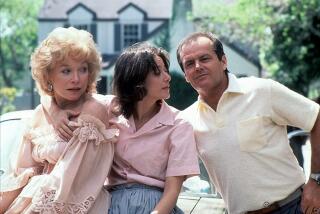Bringing Up Cary
- Share via
Though he began his life as a bloke named Archie Leach from a lower-middle-class family in Bristol, England, as Cary Grant he became one of the greatest, most elegant movie stars and actors of the 20th century.
Over the next month, the Los Angeles County Museum of Art will celebrate the diverse career of the debonair, witty actor with its “Tall, Dark and Handsome” film festival. The series kicks off Friday with two of his comedic triumphs, 1937’s “The Awful Truth” and 1944’s “Arsenic and Old Lace.”
Ian Birnie, head of LACMA’s film department, doesn’t usually devote a screen series to a single actor. But Grant, who died in 1986 at age 82, has always been a personal favorite.
“He had such a big career,” says Birnie. “We had done Humphrey Bogart about a year ago, and it was fascinating to see someone who you think of as a single image and to look at the different facets through their career. I was kind of thinking to myself, who has a career similar to Bogart’s, who has such a broad appeal and a huge amount of work? Cary Grant was the only person who comes to mind who is a star on that level--at once a real movie star and a real actor.”
Unlike a lot of his peers, Grant was equally at ease playing drawing-room comedy, slapstick roles, dark drama and action-adventure. Birnie points to Grant’s impeccable timing in his movies. “You feel these beautiful beats in his movies,” he says. “You always feel like he is listening to the other actors, too, and responding to them beautifully.”
When Archie Leach was 9, his mother was sent to a mental institution. The young boy, though, was told his mother had gone to a seaside resort. He didn’t see her again until he was in his late 20s. Five years after his mother left, he quit school and forged his father’s signature on a letter to join Bob Pender’s troupe of comedians. As a member of the troupe, he learned pantomime and acrobatics and even picked up a Cockney accent working in the London music halls.
In 1920, he was one of eight Pender boys chosen to go to America to appear in the Broadway show “Good Times.” After struggling in America to make ends meet after the show closed, Grant returned to England, where he began working as a leading man in light-comedy stage plays. He came back to America in the late ‘20s, finding work in Broadway and touring companies.
In 1931, he appeared in the Paramount musical short “Singapore Sue.” The next year, he was put under contract with Paramount, where his name was changed to Cary Grant.
Grant quickly worked his way up the studio ladder, hitting stardom in his eighth film, the ribald 1933 Mae West comedy “She Done Him Wrong.” West allegedly remarked of Grant: “If that man can talk, I want him for my co-star.”
Over the next 33 years, Grant worked with such legendary directors as Alfred Hitchcock, Leo McCarey, Frank Capra, Howard Hawks, George Cukor, Richard Brooks, Joseph Mankiewicz and Stanley Donen. And he kept honing the Cary Grant persona. Early in his career, he was beefy with a tad too much pomade in his hair. As the year went by, Grant became leaner, less slick and more sophisticated.
“Everyone wants to be Cary Grant,” he once famously said. “Even I want to be Cary Grant.”
Though he often played happily married men on screen, in real life four of his five marriages ended in divorce.
“He is famous for guarding his privacy,” says Birnie. “Yet he is prepared to make such a fool of himself in front of the camera. For such a handsome man, I can’t think of any actor who could be as urbane as Cary Grant and yet be as silly on screen. He lacked the self-consciousness that matinee idols have. I do think the camera brought something out in him, his character.”
The “Tall, Dark and Handsome” series shines the spotlight on such well-known Grant comedies as 1940’s “The Philadelphia Story” and 1938’s “Holiday” (June 16); 1940’s “His Girl Friday” and 1959’s “Operation Petticoat” (June 23); and 1938’s “Bringing Up Baby” and “Mr. Blandings Builds His Dream House” (June 29).
The older Grant is on display in Saturday’s double bill of 1963’s “Charade” and 1955’s “To Catch a Thief.” In “Charade,” directed by Donen, Grant plays a mysterious man who helps recently widowed Audrey Hepburn locate her husband’s murderer, as well the whereabouts of the loot her husband had stolen during World War II. Grant and Hepburn have some wonderfully sexy and funny scenes together, especially a sequence in which Grant takes a shower fully clothed as Hepburn looks on.
“To Catch a Thief,” directed by Hitchcock, is a colorful bauble in which Grant plays a reformed cat burglar who is suspected of a series of jewel robberies on the French Riviera. He meets his match when he falls in love with a rich American tourist played by the ever graceful Grace Kelly.
Scheduled for June 15 is a triple bill of three pre-Hays Code comedies Grant made early in his career, including his first feature film, 1932’s “This Is the Night,” in which he plays a famous javelin thrower. In “She Done Him Wrong,” West tells Grant’s Salvation Army corporal “to come up and see me sometime.” Rounding out the evening is the rarely seen 1934 comedy “Thirty Day Princess,” which was co-written by Preston Sturges.
Grant gives a wonderful dramatic turn in Howard Hawks’ 1939 classic adventure “Only Angels Have Wings,” screening June 22. Set in South America, “Angels” finds Grant as the rather callous leader of a group of mail pilots who risk their lives to deliver goods over the Andes. Penned by the great Jules Furthman, “Angels” also stars Jean Arthur, a young Rita Hayworth, Thomas Mitchell and Richard Barthlemess.
Also screening that evening is another great adventure from 1939, “Gunga Din,” directed by George Stevens. Based on the Rudyard Kipling story, this period piece follows the escapades of three men in Her Majesty’s Indian Regiment: Grant, Douglas Fairbanks Jr. and Victor McLaglen. Grant excels as a carefree Cockney sergeant.
Grant eschews his urbane image in two underrated films screening June 28: 1936’s “Sylvia Scarlett” and 1944’s “None but the Lonely Heart.”
“Scarlett,” directed by Cukor, features Grant as a devil-may-care Cockney con artist, Jimmy “Monk” Monkley, who teams up with father (Edmund Gwenn) and daughter (Katharine Hepburn) thieves. Hepburn spends most of the movie disguised as a man. Brian Aherne also stars.
Grant received his second best actor Oscar nomination (he was first nominated for 1941’s “Penny Serenade”) for his gripping, angry performance as an embittered Cockney who leads a life of crime in “None but the Lonely Heart.” Ethel Barrymore received a supporting actress Oscar for her moving portrayal of his dying mother. Grant’s friend, Clifford Odets, wrote and directed this dark drama, which failed to find an audience in 1944.
Set for June 30 are two immensely popular Grant films from his latter years: 1958’s romantic comedy “Indiscreet,” directed by Donen and starring Ingrid Bergman, and the incredibly weepy 1957 melodrama “An Affair to Remember,” with Deborah Kerr.
The series concludes July 6 and 7 with a weekend of three Grant classics directed by Hitchcock that show a darker side to the Grant persona: 1946’s “Notorious,” with Bergman and Claude Rains; 1941’s “Suspicion,” co-starring Joan Fontaine; and 1959’s “North by Northwest.”
LACMA’s Tuesday movie matinees will also be devoted to Grant with 1944’s “Once Upon a Honeymoon” screening this coming Tuesday; 1948’s “Every Girl Should Be Married,” featuring third wife Betsy Drake, scheduled for June 19; the 1939 melodrama “In Name Only,” set for June 26; and the 1943 World War II thriller “Destination Tokyo,” screening July 3.* “Tall, Dark and Handsome” screens at the Los Angeles County Museum of Art, Bing Theater, 5905 Wilshire Blvd., L.A. Programs begin at 7:30 p.m. Admission is $7; $5, for museum members, members of AFI, seniors (62 and older) and students with valid ID. Matinee times are 1 p.m. Admission is $2-$1. For information, call 323-857-6010.
More to Read
Only good movies
Get the Indie Focus newsletter, Mark Olsen's weekly guide to the world of cinema.
You may occasionally receive promotional content from the Los Angeles Times.











